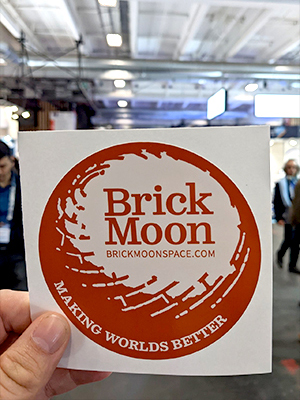September 19, 2022 — The only archaeologists to have studied how astronauts live while on board the International Space Station are now offering to advise the designers of the next orbiting outposts.
The co-directors of the International Space Station Archaeological Project (ISSAP) have partnered with an architect to found Brick Moon, a new consultancy firm that is aimed at helping improve productivity, reduce costs and support crew well-being aboard new space habitats. Brick Moon is making its formal debut this week at the International Astronautical Congress (IAC) in Paris, France.
"We're really excited about this," Justin Walsh, co-founder of Brick Moon and co-director of the ISS Archaeological Project, said in an interview with collectSPACE. "It is chance for us to move from the basic research of the International Space Station Archaeological Project to applied research in a sense, where we are taking problems presented to us by space habitat designers, mission planners and the like and answering those questions based on the results we have been finding and the experiences we've had doing the archaeological and other research under the ISSAP label."
Established by Walsh and fellow "space archaeologist" Alice Gorman in 2015, the ISS Archaeological Project was the first large-scale space archaeology study and the first to focus on an operational space habitat. The project looked at the refuse returned from the International Space Station and, working with the crew aboard the orbiting laboratory, established "dig sites" to better understand the needs of the people who have continuously lived aboard the station for more than 20 years.
The ISS Archaeological Project is continuing, but it has reached the point where its results can now be of use to more than just researchers, according to Walsh.
"We're really pumping out the results," he said. "That was one of the reasons that it felt like we had a critical mass in terms of the things that we've learned and we're able to talk about that could really help designers figure out better ways to do what they want to do, more efficient ways to do what they want to do and maybe less costly ways to do what they want to do."
"Our driving goal is how do we make life better on future space habitats," Walsh said. "As social scientists — and our colleague Fred [Scharmen] is an architectural designer — we are human-centered in trying to understand what's the experience of people living in space."
"And we know that if we want to achieve our goal that we have to engage with the people who are building the future space habitats," he said.
Several companies are designing privately-operated space stations to be ready for when the International Space Station is decommissioned between 2024 and 2030. Axiom Space is now building its first modules that under a NASA contract will be docked to the ISS for testing before becoming a free-flying, independent platform. Separately, Blue Origin and Sierra Space are developing "Orbital Reef" to become a "mixed-use business park" in low Earth orbit.
Similarly, Nanoracks is working with Lockheed Martin to deploy Starlab with the George Washington Carver (GWC) Science Park at its core. Beyond Earth, NASA is working with Northrop Grumman and Maxar, as well as its international partners, to build the Gateway, a human-tended station orbiting the moon.
Walsh said that he and his colleagues have been in touch with all of the players in the new space habitat business.
"We have talked to pretty much everybody, although not within the guise of Brick Moon, because Brick Moon is brand new," he told collectSPACE. "We've been letting them know, kind of quietly, that this is something that we're planning and we are at IAC this week where we are talking to a lot of those people about what we can offer and what our plans are for the future."
"They know that they don't have the run up time that ISS had," said Walsh, referring to the years of on-orbit development before full utilization began. "They need to be ready to go, ready to have customers in place and be able to serve those customers, so there are concerns for them, like how are they going to use their spaces properly and what kinds of things are they going to need aboard those space stations to be ready for their clients? And that's where we come in."
In that sense, Brick Moon's first lesson is not to be like "The Brick Moon." The namesake for the new company, "The Brick Moon" is an 1869 science fiction novella by Edward Everett Hale that includes the first description of a fictional space station. In the story, a large brick-built sphere intended as a navigational device is accidentally launched with people on board.
"We just really love that story," said Walsh. "It really takes us back to the full amount of time that people have been imagining living in space. I don't think most people think that's how long people have been thinking about it." |
|

Space archaeologist Justin Walsh, co-founder of Brick Moon, holds up a decal with the new space habitat consultancy's logo at the International Astronautical Congress (IAC) in Paris. (Brick Moon)

Commercial space station concepts developed by Axiom Space (at left), Nanoracks (top right) and Blue Origin with Sierra Space.

Alice Gorman, Fred Scharmen and Justin Walsh co-founded Brick Moon as a spinoff of the International Space Station Archaeological Project established by Gorman and Walsh in 2015. (Brick Moon) |
